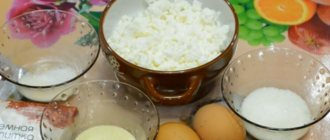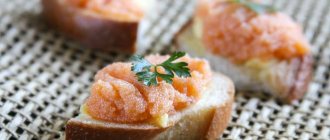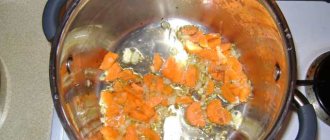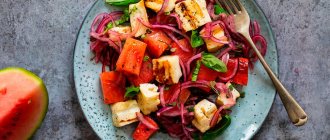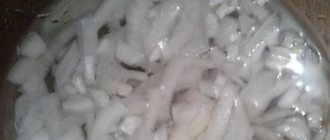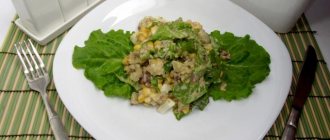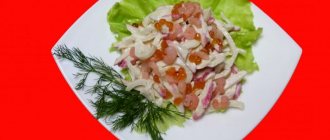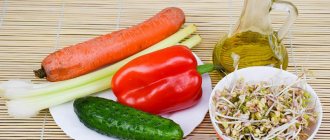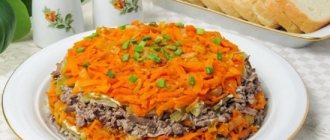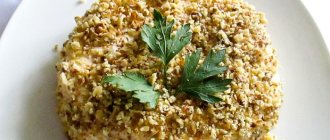Tabbouleh is a popular Arabic dish that can be classified as a salad. This oriental appetizer is fresh, light, but filling. It is based on one of the varieties of wheat cereal (most often bulgur) and fresh herbs (mainly parsley and mint). Often the composition includes fresh vegetables. Dress the salad with a mixture of lemon juice and oil. Tabbouleh can be called a dietary dish; this salad is of interest to healthy eating enthusiasts and vegetarians, but few people know how to prepare it.
Cooking features
Even an inexperienced cook can handle preparing tabbouleh, and it will only take a little time. However, a novice housewife, unfamiliar with the technology of preparing this dish, will almost certainly experience some difficulties, not knowing what exactly to do with the products included in the snack. The secrets of experienced chefs will help you feel confident in your abilities and do everything right.
- Most often, tabbouleh includes bulgur or couscous, popular in many eastern countries. Both products are made from wheat, but using different technologies. To produce bulgur, millet is treated with boiling water and finely crushed. Couscous is made from semolina by sprinkling it with water and treating it with flour or dry semolina, which is why it takes on the appearance of small pellets. The technology for preparing dishes from these cereals is approximately the same: they are poured with boiling water and left for 5 minutes, after which they are loosened with a spoon or fork. These grains should not be washed. If the bulgur is not small enough, it may need to be cooked. In this case, the cereal is first fried in oil, then poured with water in a ratio of 1:2 and cooked until the cereal absorbs all the liquid. The technology for preparing bulgur and couscous is usually described on the packaging. Some countries use larger versions of wheat cereal. For example, in Armenia tabbouleh is made from pearl barley. In order for it to boil well, it should be soaked first.
- The main ingredient in tabbouleh is fresh herbs. You need to cut it not too finely, using a sharp knife so that the juice does not remain on the cutting board, but soaks the cereal well. The most commonly used herb is parsley. Be sure to add a small amount of fresh mint to the salad.
- Before putting the cereal in the salad, it needs to be cooled, otherwise the snack will be less tasty and will quickly spoil.
The classic tabbouleh recipe, which is used in almost all Arab countries, is extremely simple: it contains nothing but cereals, herbs and onions. However, the recipe is often supplemented with fresh vegetables. The most famous and popular in our country are the Lebanese and Armenian versions of this dish.
Tabbouleh - 3 salads with bulgur, quinoa and couscous + all the secrets
- It’s either a salad or a light vegetable pilaf, but it’s definitely a healthy idea with an abundance of vitamins and vegetable protein. Tabbouleh - a classic recipe with bulgur and a gluten-free version with quinoa - are the heroes of our story. And for dessert, another classic from the shores of the Mediterranean - in an elegant video recipe.
We'll show you how to prepare grains, chop vegetables, and make salad dressing. We will also offer new interesting combinations for this healthy dish - couscous, quinoa, adding chickpeas.
Quick navigation through the article:
Classic tabbouleh recipe
Compound:
- bulgur – 50 g;
- fresh parsley – 0.2 kg;
- onions – 50 g;
- lemon – 1 pc.;
- fresh mint – 20 g;
- vegetable oil – 40 ml;
- salt - to taste.
Cooking method:
- Pour boiling water over the bulgur, cover with a lid. After 5-10 minutes, fluff with a fork. Wait for it to cool down. If you have a variety of bulgur that requires cooking, cook the cereal according to the instructions on the package and also cool.
- Peel the onion and cut into thin rings. Red onions will look good in a salad.
- Wash and shake off the water from the mint and parsley. Dry the greens with napkins.
- Set aside a sprig of mint to garnish the appetizer, finely chop the rest with a sharp knife.
- Chop the parsley, but not too finely.
- Place bulgur, parsley and mint in a bowl. Stir.
- In a separate container, mix squeezed lemon juice and vegetable oil. Salt the dressing. You can add some oriental spices.
- Pour the resulting sauce over the ingredients and stir again.
- Place the salad in a salad bowl or on a plate. Place onion rings on it. Stick a sprig of mint on top.
Bulgur in this recipe can be replaced with couscous. The onion can be chopped smaller and mixed with the rest of the ingredients before dressing the salad with sauce. Sometimes sweet peppers are added to the recipe. In this case, you need to take it in moderation: for the amount of ingredients indicated in the recipe, it is enough to use 50 g of pepper, cut into small strips or small squares.
Traditional tabbouleh with bulgur recipe
Cooks often call this salad a side dish. Perhaps this is correct, since, as practice shows, it is served in combination with sauces and meat dishes.
Lebanese tabbouleh salad is prepared in different ways. It can be based on couscous or bulgur. The cereal is soaked or boiled. Add greens to it. In the classic version, this is parsley, and you need to do painstaking work: separate the small leaves from the branches.
Refined olive oil is combined with freshly squeezed lemon juice to create an incredibly tasty gravy.
On a note! In some recipes, vegetables are added to Tabula, in particular fresh cucumbers and tomatoes. This dish can be served as an appetizer or side dish.
Compound:
- 3 tbsp. l. bulgur;
- 1 tbsp. filtered water;
- 500 g fresh tomatoes;
- 2 pcs. fresh cucumbers;
- 3 tbsp. l. dried mint;
- 2 tbsp. l. dried basil;
- half a head of garlic;
- ½ lemon;
- 5 tbsp. l. refined olive oil.
Preparation:
- Place the bulgur in a bowl and pour a glass of boiling water.
- Leave the cereal in this form overnight.
- The next day, drain the remaining water.
- Peel the garlic cloves and finely chop them with a knife.
- Combine chopped garlic with dried mint and basil.
- Squeeze the juice out of half a lemon and add it to the above ingredients.
- Pour in refined olive oil and mix well.
- We wash fresh cucumbers and remove any remaining moisture with a paper towel.
- Chop the cucumbers into cubes and immediately place them in a salad bowl.
- We wash fresh tomatoes and make a cross-shaped cut on top.
- Pour boiling water over them and leave for a couple of minutes.
- Carefully remove the skin.
- Chop the tomato pulp and add to the salad bowl.
- Add bulgur and prepared dressing to the vegetables.
- Mix all ingredients thoroughly.
- Place the salad in the refrigerator for several hours to infuse.
Tabbouleh in Armenian
Compound:
- pearl barley – 150 g;
- sun-dried tomatoes – 20 g;
- pitted olives – 20 g;
- pine nuts – 20 g;
- fresh cucumber – 150 g;
- canned corn – 130 g;
- fresh parsley – 100 g;
- mint – 40 g;
- basil – 40 g;
- olive oil – 40 ml;
- lemon juice – 20 ml;
- goat cheese – 100 g.
Cooking method:
- Sort and rinse the pearl barley, cover with water for 2 hours, and rinse again. Fill with clean water and boil until tender. Drain in a colander and rinse again. Let the water drain and the cereal cool and dry.
- Wash and shake off the greens. When it dries, chop it finely with a knife and put it in a bowl.
- Toast the pine nuts in a dry frying pan and add to the greens.
- Cut the tomatoes and olives into small pieces and add to the rest of the ingredients.
- Wash the cucumber and pat dry with a napkin. Cut off the ends. Cut the vegetable into small cubes. Place in a bowl with the rest of the ingredients.
- Add cooled pearl barley to the crushed products.
- Add corn. This ingredient is not necessary in the salad, but gives it a special taste.
- Season the salad with a mixture of lemon juice and olive oil.
- Place the salad on a plate or in a salad bowl.
- Crumble the cheese and sprinkle it over the salad.
GOURMET. We prepare dishes of Armenian cuisine: khash, tabbouleh and kufta
Chef Raisa Savkova shared the best recipes for Armenian dishes with a correspondent of the Minsk-Novosti agency.
Raisa has been cooking for over 30 years and is well acquainted with the cuisine of different nations. Several years ago she visited Armenia, and she developed another passion - the dishes of this country.
“Armenian cuisine is rich and varied, recipes have been preserved since ancient times,” says the Minsk resident. — Juicy, steaming kebab, or khorovats, as the locals call it, baked vegetables, tender dolma - real gastronomic masterpieces. It's impossible to resist.
Not a single Armenian feast is complete without fresh vegetables, herbs, lavash, cheeses, dairy products and, of course, homemade wine. There are small wineries in almost every village courtyard.
“Nevertheless, I have never met a drunk person in Armenia,” continues Raisa. — Winemaking is part of culture, it is treated with respect.
She admits that in Armenian cuisine she was struck by the abundance of herbs and spices used for cooking. Some are used as seasonings and even as a main dish. The most popular are pepper, cilantro, fenugreek, mint, tarragon, basil and garlic.
“Armenians mainly cook with ghee,” says Raisa Savkova. — Meat is simmered in soups for a long time. Rich khash, for example, is cooked for more than eight hours. This is why the dishes acquire a unique taste.
Basturma
Traditionally it is prepared by men. It is believed that only they can choose a worthy piece of tenderloin and choose the wine for the marinade. Armenian basturma always contains chaman (fenugreek) and sumac (ground pomegranate dried in a special way).
1 kg veal tenderloin.
For the marinade: 1 liter of homemade red wine, 7 tbsp. l. sea salt, head of garlic, 4 tsp. red pepper, 1 tbsp. l. sumac seasoning.
Dough for coating meat: 0.75 tbsp. dry red wine, 4 tsp. salt, 2 tsp. sumac and chamana, 3 tsp. hot red pepper, flour.
Chop the garlic and mix with the ingredients for the marinade.
Immerse the washed tenderloin in the spiced wine until it is completely covered with liquid. On top there is gauze and a press. Leave in a cool place covered for a week.
Prepare a dough based on wine and seasonings for coating. The consistency is a little thicker than pancakes. Cover the meat with dough approximately 3 mm thick.
In a separate bowl, mix spices and salt. When the dough dries but remains sticky, roll the dough.
Pierce the beef with a hook and hang in a cool, dry place. After two weeks, enjoy homemade basturma.
Tabbouleh
Light and tasty salad. Most likely, he entered Armenia through Lebanese Armenians. Tabbouleh goes great with barbecue, baked meat, and poultry.
150 g bulgur, 4 tomatoes, large onion, 2 bunches of parsley and cilantro, 4 tbsp. l. olive oil, 1 tsp. lemon juice, ground black pepper, salt to taste.
Pour boiling water over the bulgur (the volume of water is 2 times its weight) and leave for 1.5 hours. Place in a colander and allow excess liquid to drain.
Place the tomatoes in boiling water, remove the skin and cut into cubes. Finely chop the greens and onions, add tomatoes, season with lemon juice, vegetable oil, salt and pepper. Mix with bulgur and refrigerate for 2 hours to soak the salad.
Hash
In ancient times it was called the poor man's dish. Traditional Armenian khash is made from beef legs, tripe and garlic. A hearty soup satisfies hunger for a long time and contains a lot of calcium and other useful microelements. Soviet doctors recommended using it after fractures and sprains. Excellent hangover reliever. Served for breakfast.
1 kg of beef legs, 0.5 kg of beef tripe, 4 heads of garlic, 150 g each of parsley, basil, cilantro, bay leaf, black peppercorns, salt to taste.
Wash and clean the feet thoroughly, chop them, add water, leave for a day, changing the water after 2-3 hours. Fill with water so that the liquid is 20 cm higher. Cook over low heat for about 8 hours until the meat comes off the bones. Skim off foam during cooking.
Rinse the tripe, add water, cook for 15-20 minutes to remove the specific smell. Drain the water, rinse the tripe and put it back on the fire for 1.5-2 hours. Cool, cut into small pieces, add to the soup being prepared. Add bay leaf and peppercorns.
Separate the finished meat from the bones, chop and return to the rich broth. Chop the garlic and rub with salt.
Place garlic dressing in a deep soup bowl, pour hot khash, add chopped herbs. Eat with lavash and grated radish.
Kufta
This is the pride of Armenian cuisine. Not a single wedding or other celebration is complete without a kufta.
500 g beef or veal, egg, onion, 3/4 tbsp. milk, 1 tbsp. l. flour, 25 g cognac, ghee or olive oil.
Cut the meat into layers and beat with a wooden mallet until smooth. The main criterion is that there is no work for the teeth. Beat egg, milk, flour, spices and salt. Pour the mixture into the minced meat, add finely chopped onion. Lightly whisk and mix thoroughly.
Add cognac to the minced meat and roll into balls. Place in cold salted water and bring to a boil, cook for 35 minutes. Remove with a slotted spoon. Drizzle with oil and sprinkle with herbs.
Serve on pita bread with pickled cucumbers. Homemade noodles, baked vegetables, and potatoes are suitable as a side dish.
Beef pilaf with dried fruits
800 g beef, 500 g rice, 2 carrots, a head of garlic, 100 g prunes, 100 g raisins, spices, salt to taste.
Cut the meat into small cubes, fry in a cauldron in vegetable oil with carrot sticks, season with spices. Stir and simmer over low heat for 30 minutes.
Rinse the rice, place it in an even layer on the meat, add water to cover 2 cm above. In the middle - unpeeled garlic. Cover and cook over low heat for 40 minutes until the rice is tender.
Add prunes, raisins to the finished pilaf and mix. Before serving, you can garnish with chopped herbs.
Photo from the archive of Raisa Savkova
More materials from the section:
GOURMET. Cooking pancake dishes
GOURMET. Georgian recipes
GOURMET. We prepare delicious low-calorie pizza from pumpkin, bran and zucchini
GOURMET. Fry, make honey and make jam: what else can you do with watermelon
GOURMET. Chickpea Fritters, Tofu Spinach Quiche, Sweet Rice and More Vegan Recipes
minsknews.by
Tabbouleh recipe. Calorie, chemical composition and nutritional value.
Nutritional value and chemical composition of Tabbouleh.
The table shows the nutritional content (calories, proteins, fats, carbohydrates, vitamins and minerals) per 100 grams of edible portion.
| Nutrient | Quantity | Norm** | % of the norm in 100 g | % of the norm in 100 kcal | 100% normal |
| Calorie content | 82.3 kcal | 1684 kcal | 4.9% | 6% | 2046 g |
| Squirrels | 2.2 g | 76 g | 2.9% | 3.5% | 3455 g |
| Fats | 3.5 g | 56 g | 6.3% | 7.7% | 1600 g |
| Carbohydrates | 9.9 g | 219 g | 4.5% | 5.5% | 2212 g |
| Organic acids | 0.1 g | ~ | |||
| Alimentary fiber | 2 g | 20 g | 10% | 12.2% | 1000 g |
| Water | 81.7 g | 2273 g | 3.6% | 4.4% | 2782 g |
| Ash | 0.666 g | ~ | |||
| Vitamins | |||||
| Vitamin A, RE | 143.5 mcg | 900 mcg | 15.9% | 19.3% | 627 g |
| beta carotene | 0.896 mg | 5 mg | 17.9% | 21.7% | 558 g |
| Lutein + Zeaxanthin | 193.632 mcg | ~ | |||
| Vitamin B1, thiamine | 0.05 mg | 1.5 mg | 3.3% | 4% | 3000 g |
| Vitamin B2, riboflavin | 0.044 mg | 1.8 mg | 2.4% | 2.9% | 4091 g |
| Vitamin B4, choline | 5.49 mg | 500 mg | 1.1% | 1.3% | 9107 g |
| Vitamin B5, pantothenic | 0.163 mg | 5 mg | 3.3% | 4% | 3067 g |
| Vitamin B6, pyridoxine | 0.074 mg | 2 mg | 3.7% | 4.5% | 2703 g |
| Vitamin B9, folates | 17.665 mcg | 400 mcg | 4.4% | 5.3% | 2264 g |
| Vitamin C, ascorbic acid | 22.41 mg | 90 mg | 24.9% | 30.3% | 402 g |
| Vitamin E, alpha tocopherol, TE | 0.672 mg | 15 mg | 4.5% | 5.5% | 2232 g |
| Vitamin H, biotin | 0.134 mcg | 50 mcg | 0.3% | 0.4% | 37313 g |
| Vitamin K, phylloquinone | 146 mcg | 120 mcg | 121.7% | 147.9% | 82 g |
| Vitamin RR, NE | 0.9783 mg | 20 mg | 4.9% | 6% | 2044 g |
| Niacin | 0.274 mg | ~ | |||
| Betaine | 0.005 mg | ~ | |||
| Macronutrients | |||||
| Potassium, K | 244.63 mg | 2500 mg | 9.8% | 11.9% | 1022 g |
| Calcium, Ca | 44.92 mg | 1000 mg | 4.5% | 5.5% | 2226 g |
| Silicon, Si | 3.915 mg | 30 mg | 13.1% | 15.9% | 766 g |
| Magnesium, Mg | 29.93 mg | 400 mg | 7.5% | 9.1% | 1336 g |
| Sodium, Na | 12.8 mg | 1300 mg | 1% | 1.2% | 10156 g |
| Sera, S | 25.41 mg | 1000 mg | 2.5% | 3% | 3935 g |
| Phosphorus, Ph | 60.9 mg | 800 mg | 7.6% | 9.2% | 1314 g |
| Chlorine, Cl | 40 mg | 2300 mg | 1.7% | 2.1% | 5750 g |
| Microelements | |||||
| Aluminium, Al | 134.7 mcg | ~ | |||
| Bor, B | 74.6 mcg | ~ | |||
| Vanadium, V | 3.24 mcg | ~ | |||
| Iron, Fe | 0.813 mg | 18 mg | 4.5% | 5.5% | 2214 g |
| Yod, I | 1.24 mcg | 150 mcg | 0.8% | 1% | 12097 g |
| Cobalt, Co | 3.38 mcg | 10 mcg | 33.8% | 41.1% | 296 g |
| Lithium, Li | 13.137 mcg | ~ | |||
| Manganese, Mn | 0.4627 mg | 2 mg | 23.1% | 28.1% | 432 g |
| Copper, Cu | 106.13 mcg | 1000 mcg | 10.6% | 12.9% | 942 g |
| Molybdenum, Mo | 5.774 mcg | 70 mcg | 8.2% | 10% | 1212 g |
| Nickel, Ni | 5.884 mcg | ~ | |||
| Rubidium, Rb | 114.1 mcg | ~ | |||
| Selenium, Se | 0.502 mcg | 55 mcg | 0.9% | 1.1% | 10956 g |
| Strontium, Sr | 4.52 mcg | ~ | |||
| Fluorine, F | 55.66 mcg | 4000 mcg | 1.4% | 1.7% | 7186 g |
| Chromium, Cr | 2.78 mcg | 50 mcg | 5.6% | 6.8% | 1799 |
| Zinc, Zn | 0.4363 mg | 12 mg | 3.6% | 4.4% | 2750 g |
| Zirconium, Zr | 1.81 mcg | ~ | |||
| Digestible carbohydrates | |||||
| Starch and dextrins | 0.097 g | ~ | |||
| Mono- and disaccharides (sugars) | 2.1 g | max 100 g | |||
| Essential amino acids | |||||
| Arginine* | 0.068 g | ~ | |||
| Valin | 0.065 g | ~ | |||
| Histidine* | 0.034 g | ~ | |||
| Isoleucine | 0.054 g | ~ | |||
| Leucine | 0.098 g | ~ | |||
| Lysine | 0.04 g | ~ | |||
| Methionine | 0.022 g | ~ | |||
| Threonine | 0.042 g | ~ | |||
| Tryptophan | 0.022 g | ~ | |||
| Phenylalanine | 0.068 g | ~ | |||
| Nonessential amino acids | |||||
| Alanin | 0.051 g | ~ | |||
| Aspartic acid | 0.074 g | ~ | |||
| Glycine | 0.058 g | ~ | |||
| Glutamic acid | 0.457 g | ~ | |||
| Proline | 0.15 g | ~ | |||
| Serin | 0.068 g | ~ | |||
| Tyrosine | 0.042 g | ~ | |||
| Cysteine | 0.034 g | ~ | |||
| Sterols (sterols) | |||||
| beta sitosterol | 3.302 mg | ~ | |||
| Saturated fatty acids | |||||
| Saturated fatty acids | 0.6 g | max 18.7 g | |||
| 8:0 Caprylic | 0.002 g | ~ | |||
| 16:0 Palmitinaya | 0.453 g | ~ | |||
| 18:0 Stearic | 0.084 g | ~ | |||
| 20:0 Arakhinovaya | 0.028 g | ~ | |||
| Monounsaturated fatty acids | 2.232 g | min 16.8 g | 13.3% | 16.2% | |
| 16:1 Palmitoleic | 0.052 g | ~ | |||
| 18:1 Oleic (omega-9) | 2.165 g | ~ | |||
| 20:1 Gadoleic (omega-9) | 0.017 g | ~ | |||
| Polyunsaturated fatty acids | 0.515 g | from 11.2 to 20.6 g | 4.6% | 5.6% | |
| 18:2 Linolevaya | 0.463 g | ~ | |||
| 18:3 Linolenic | 0.011 g | ~ | |||
| Omega-6 fatty acids | 0.5 g | from 4.7 to 16.8 g | 10.6% | 12.9% |
The energy value of Tabbouleh is 82.3 kcal.
Primary Source: Created in the application by the user. Read more.
** This table shows the average levels of vitamins and minerals for an adult. If you want to know the norms taking into account your gender, age and other factors, then use the “My Healthy Diet” application.
